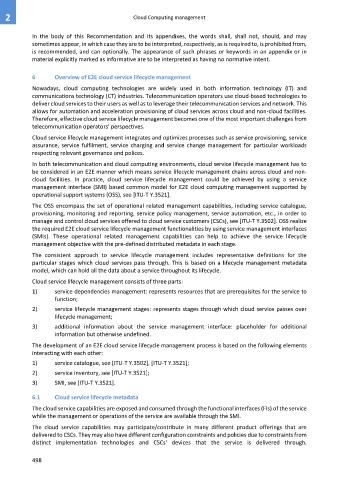Page 506 - Cloud computing: From paradigm to operation
P. 506
2 Cloud Computing management
In the body of this Recommendation and its appendixes, the words shall, shall not, should, and may
sometimes appear, in which case they are to be interpreted, respectively, as is required to, is prohibited from,
is recommended, and can optionally. The appearance of such phrases or keywords in an appendix or in
material explicitly marked as informative are to be interpreted as having no normative intent.
6 Overview of E2E cloud service lifecycle management
Nowadays, cloud computing technologies are widely used in both information technology (IT) and
communications technology (CT) industries. Telecommunication operators use cloud-based technologies to
deliver cloud services to their users as well as to leverage their telecommunication services and network. This
allows for automation and acceleration provisioning of cloud services across cloud and non-cloud facilities.
Therefore, effective cloud service lifecycle management becomes one of the most important challenges from
telecommunication operators' perspectives.
Cloud service lifecycle management integrates and optimizes processes such as service provisioning, service
assurance, service fulfilment, service charging and service change management for particular workloads
respecting relevant governance and polices.
In both telecommunication and cloud computing environments, cloud service lifecycle management has to
be considered in an E2E manner which means service lifecycle management chains across cloud and non-
cloud facilities. In practice, cloud service lifecycle management could be achieved by using a service
management interface (SMI) based common model for E2E cloud computing management supported by
operational support systems (OSS), see [ITU-T Y.3521].
The OSS encompass the set of operational related management capabilities, including service catalogue,
provisioning, monitoring and reporting, service policy management, service automation, etc., in order to
manage and control cloud services offered to cloud service customers (CSCs), see [ITU-T Y.3502]. OSS realize
the required E2E cloud service lifecycle management functionalities by using service management interfaces
(SMIs). These operational related management capabilities can help to achieve the service lifecycle
management objective with the pre-defined distributed metadata in each stage.
The consistent approach to service lifecycle management includes representative definitions for the
particular stages which cloud services pass through. This is based on a lifecycle management metadata
model, which can hold all the data about a service throughout its lifecycle.
Cloud service lifecycle management consists of three parts:
1) service dependencies management: represents resources that are prerequisites for the service to
function;
2) service lifecycle management stages: represents stages through which cloud service passes over
lifecycle management;
3) additional information about the service management interface: placeholder for additional
information but otherwise undefined.
The development of an E2E cloud service lifecycle management process is based on the following elements
interacting with each other:
1) service catalogue, see [ITU-T Y.3502], [ITU-T Y.3521];
2) service inventory, see [ITU-T Y.3521];
3) SMI, see [ITU-T Y.3521].
6.1 Cloud service lifecycle metadata
The cloud service capabilities are exposed and consumed through the functional interfaces (FIs) of the service
while the management or operations of the service are available through the SMI.
The cloud service capabilities may participate/contribute in many different product offerings that are
delivered to CSCs. They may also have different configuration constraints and policies due to constraints from
distinct implementation technologies and CSCs' devices that the service is delivered through.
498

